There is no better time to play golf in New England than the six weeks from mid-September to the end of October (assuming no early winter which, in New England, you can never assume). The nights are cool and give golf course superintendents the confidence to cut greens a little closer than in the heat of the summer. The leaves on the indigenous hardwood trees turn into a kaleidoscope of colors, providing backdrops that make watching a well struck ball in flight more rewarding than usual. I can’t explain it, but as temperatures drop into the 50s and 60s, perfect for those of us who cannot tolerate the heat of summer as much as we once did, the golf courses in New England become less crowded; I’ve played two rounds on typically crowded municipal courses recently in well under four hours after starting in mid-morning.
Needless to say, I am trying to play as much golf in these six weeks as possible, and as many different courses as I can. The last three I have played were two outstanding municipal layouts in Connecticut, and one very private club in between. The first muni is my favorite course in the state, Keney Park, about which I have written in this space a few times. Keney Park, which first opened in 1929 with a nine-hole layout by Devereaux Emmet, is home to some of the most iconic features of classic golf architecture, including rectangular church pew bunkers and a Biarritz green (a gully runs through it). It begins with a very short but tricky par 4 and ends with a par 3 on which you cannot see the pin. In between is a course that demands attention given some of the largest and most demanding greens in public golf.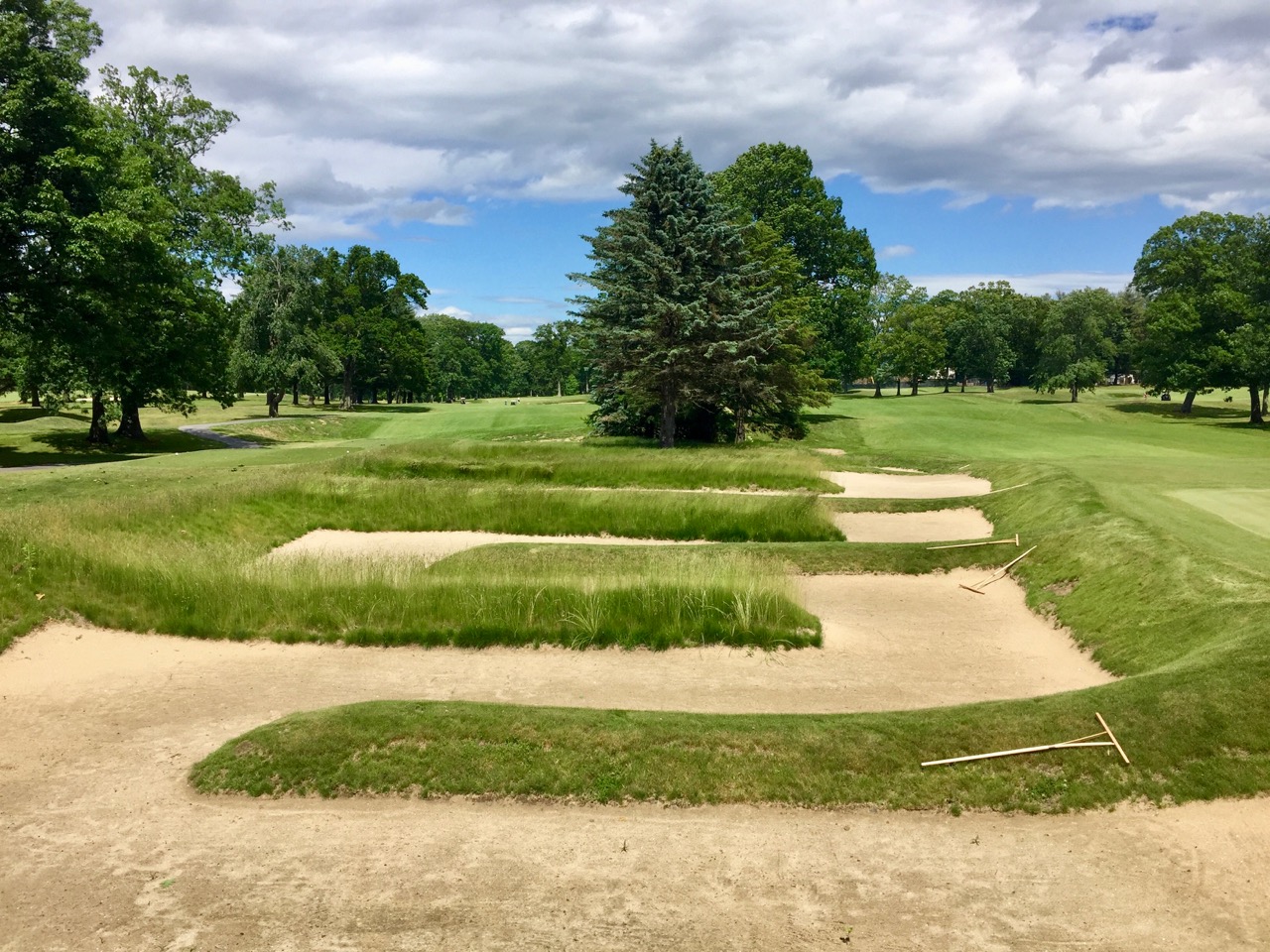 Keney Park's "church pew" bunkers are all connected, and not exactly a religious experience if you land in them.
Keney Park's "church pew" bunkers are all connected, and not exactly a religious experience if you land in them.
Last Monday, courtesy of the Junior & Senior Golfing Society of Connecticut, I was invited to play at Bulls Bridge in the mountains of northwest Connecticut, a 15-year-old course about which not much is written because of its private status and out of the way location. It is a stunning and challenging Tom Fazio design, loaded with mountain vistas and, as you might expect, significant changes in elevation. I can’t remember the last time I played a golf course with so many false fronts. The greens were still showing signs of aeration that affected a few putts; I hope the Society returns in the next couple of years for another go at Bulls Bridge, because smooth greens will only add to a terrific golfing experience.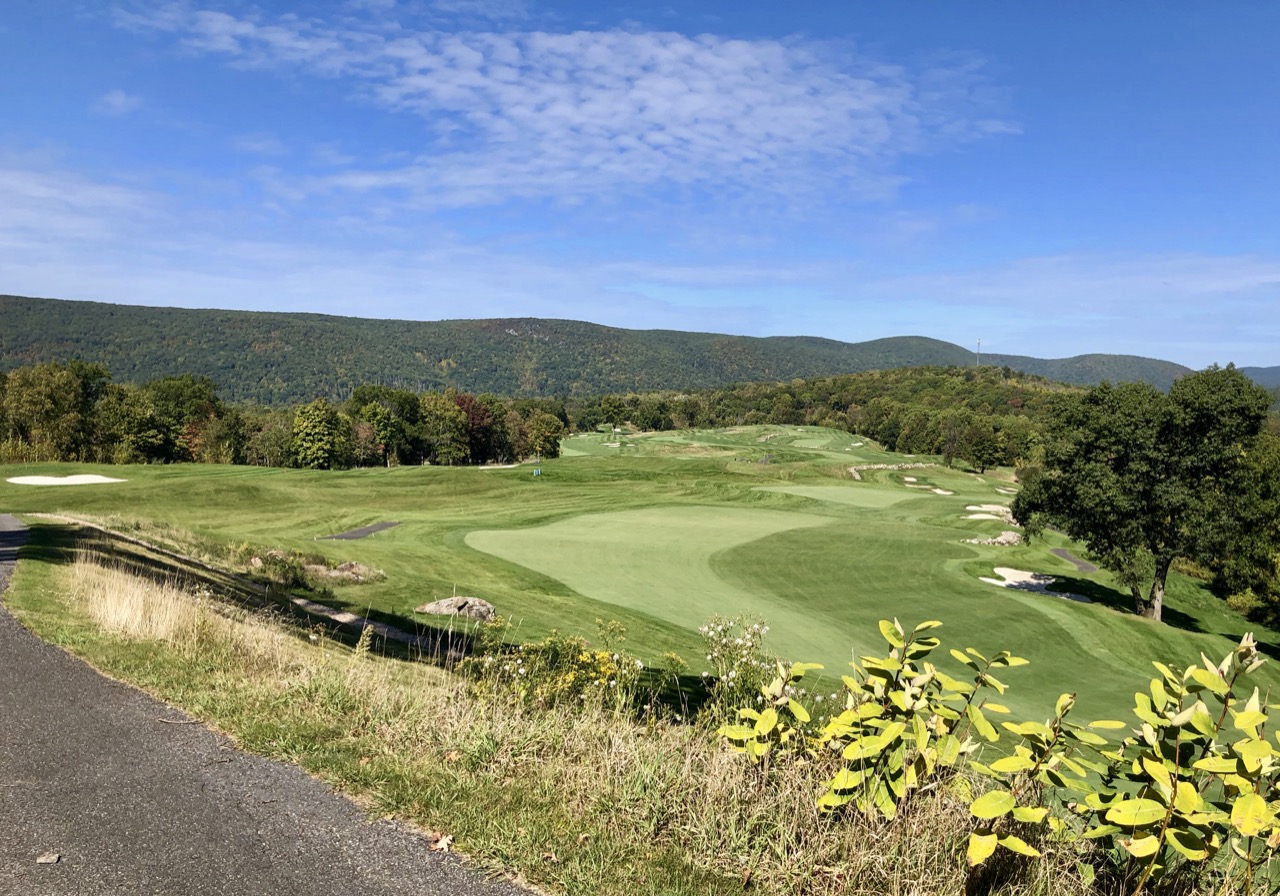 You are introduced to the many elevated tee boxes at Bulls Bridge on hole #1, a par 5 dogleg right.
You are introduced to the many elevated tee boxes at Bulls Bridge on hole #1, a par 5 dogleg right.
I wrapped up my trilogy of golf at Wintonbury Hills in Bloomfield, a town-run golf course that Pete Dye designed for the princely sum of $1. Wintonbury is not a typical Dye course in that fairway moguls and pot bunkers are kept to a minimum, and there isn’t a railroad tie in sight. But it certainly is no pushover as some holes play dramatically uphill and fairways tilt all the way to the greens on the par 5s, making long hitters think twice about the fate of their long second shots to severely sloped surrounds beside the greens (with significant trouble below). My 70-something playing companion and I were matched up with a 40-year old with a single-digit handicap who had driven an hour to play at Wintonbury; that should tell you something about the quality of the golf course and its challenge.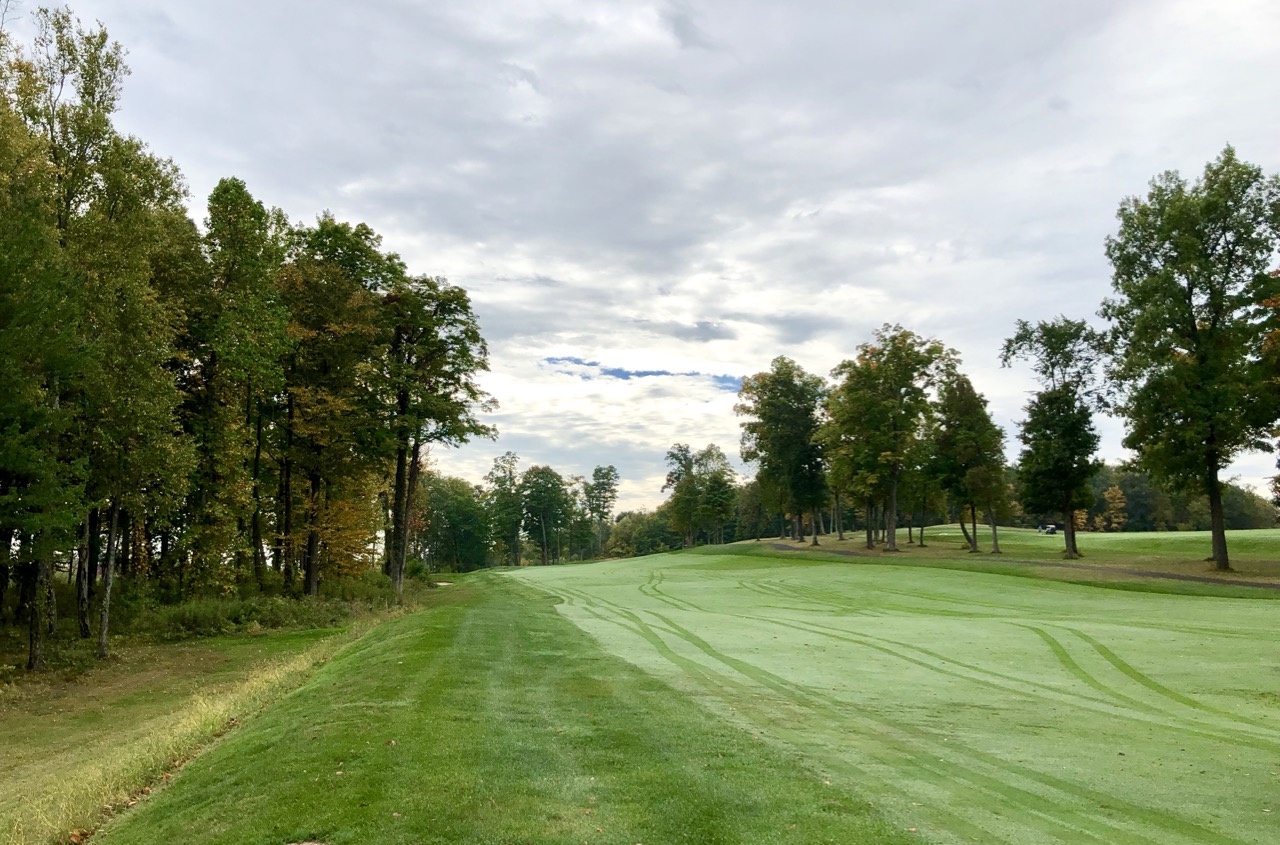 Big hitters may try to reach par 5s at Wintonbury Hills in two shots, but their second had better be aimed high right as everything bounces hard left on the 500 yard hole.
Big hitters may try to reach par 5s at Wintonbury Hills in two shots, but their second had better be aimed high right as everything bounces hard left on the 500 yard hole.
The only negative aspect of golf in New England this time of the year is that we know it will all come to an end in a matter of weeks, when we will put away the sticks until late March or early April. When play recommences, the fairways will be muddy in spots and turf will be thin. Summer arrives pretty quickly in southern New England, and those who don’t live in here might be surprised at how hot it can get by late June and right through to September.
But then autumn arrives, and golf in Connecticut becomes as good as it gets.
My round of golf at Berkleigh Country Club in Kutztown, PA, started with three pars, about as good a kickoff to a round as I can muster these days. I was playing by myself, and as I prepared for a 15-foot birdie putt on the par 3 third hole, my iPhone rang. The display indicated a call from “Reading (PA) 911.” I answered and the woman on the line asked me if I was okay. I responded that I was, thinking she sounded sincere enough that I should not add, “…and I am playing great!” She had received an “emergency” call from my phone. I apologized profusely even though I had no idea how the call had been made; all I was doing with the phone was taking photos.
After hanging up, I missed the birdie putt and drove the cart to hole #4, a short but uphill par 5. I pulled my tee shot into the rough to the left of the fairway and drove down one of the many extremely bumpy cart paths at Berkleigh; the starter had warned me about them. Halfway up the hill, I received another call from Reading 911, and the same conversation ensued. “I have no idea how it happened,” I said, “but I am going to turn off my phone.”
All I can think is that the extreme vibrations of the golf cart on the cart paths had triggered the calls. I’ve looked online, using the search terms “iPhone vibrations + 911 calls” but haven’t been able to confirm the shaking as the source. In any case, those calls shook me up a bit, and I proceeded to double bogey the par 5 with a succession of chunked and skulled shots. (I can’t blame the entire mediocre round on the calls because I birdied the par 3 6th hole.)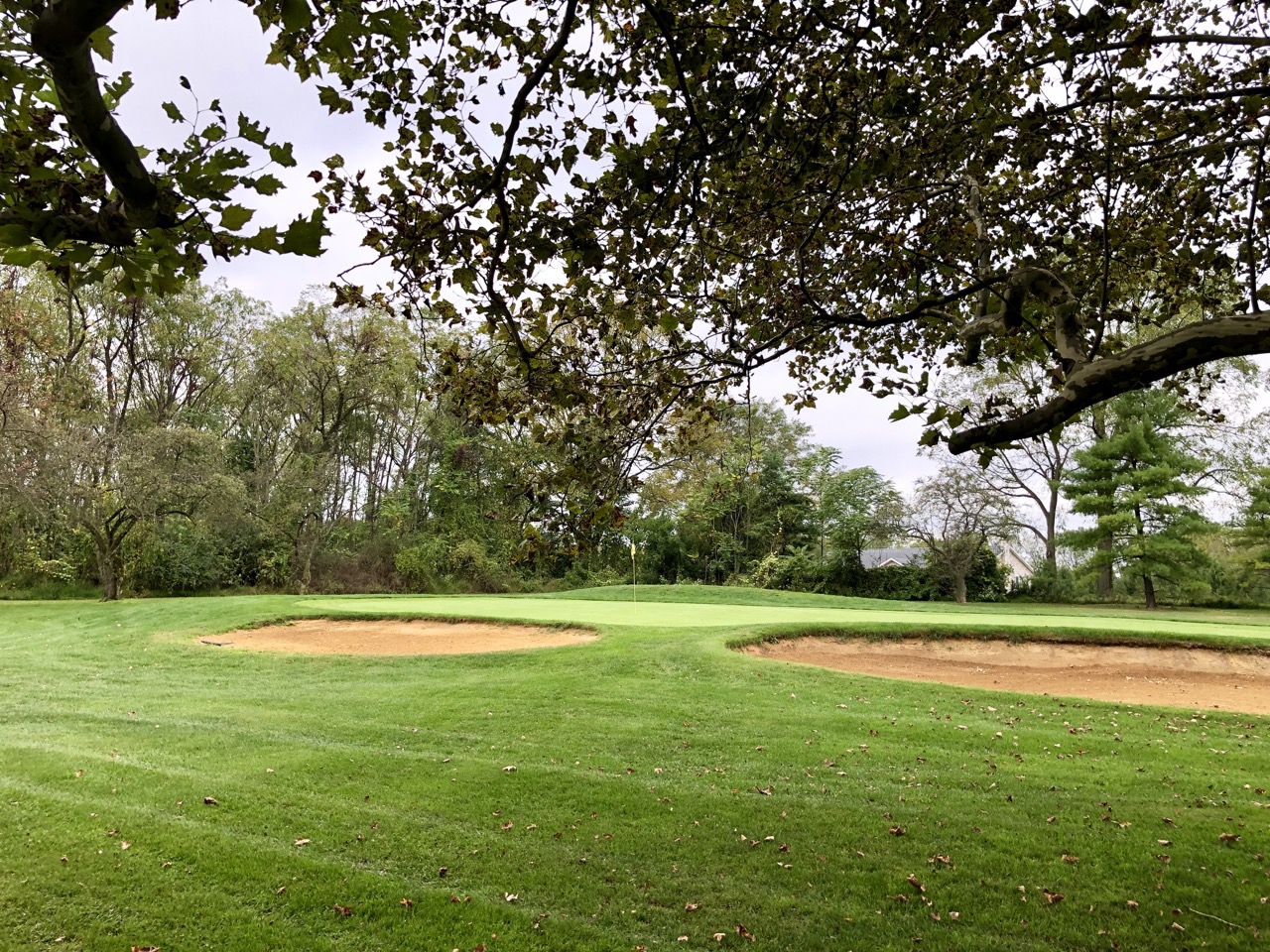 As on many a classic course, bunkers at Berkleigh are strategically placed at greenside and, more sparingly, beside fairways. False fronts and sloped fairways are more natural "hazards" that penalize sloppy shots.
As on many a classic course, bunkers at Berkleigh are strategically placed at greenside and, more sparingly, beside fairways. False fronts and sloped fairways are more natural "hazards" that penalize sloppy shots.
It occurs to me as I write this that those calls to 911 happened on the morning of 9/11. They were just part of a weird and wonderful morning at Berkleigh, which is rated by some online sources as a top 20 public golf course in the rather large state of Pennsylvania. It deserves the honor, as it combines many classic touches that remind one that elevation changes and dramatic fairway contours are fair substitutes for the large bunkering of more modern layouts. It is also in excellent condition, with greens, pockmarked like many public putting surfaces whose golfers can’t be bothered to bend over and fix a ball mark, otherwise smooth and just short of private-club fast.
At $37 including cart – the senior rate -- Berkleigh is a major bargain. Arriving at 9 a.m., mine would be the only car in the lot for the next hour; I didn’t see another soul on the golf course until I reached the back nine. I had noted as I drove through the tree-lined entrance that a beautiful old stone house was deep into restoration; the friendly starter told me it was their clubhouse but had succumbed to mold issues and ¾ of it had been taken down. They expect it to reopen next spring. The temporary pro shop, in a trailer, was in a space no bigger than an average-sized kitchen, but it was well stocked with drinks and snacks.
The golf course played a bit longer than the 6,248 yards listed for the white tees. Although only one par 4 exceeded 400 yards, others played slightly to significantly uphill, leaving me with a relatively high number of fairway wood or hybrid approach shots and justifying a slope rating of 133 against a course rating of 70.1. (Overall par was 72, with the standard array of two par 3s and two par 5s per nine.)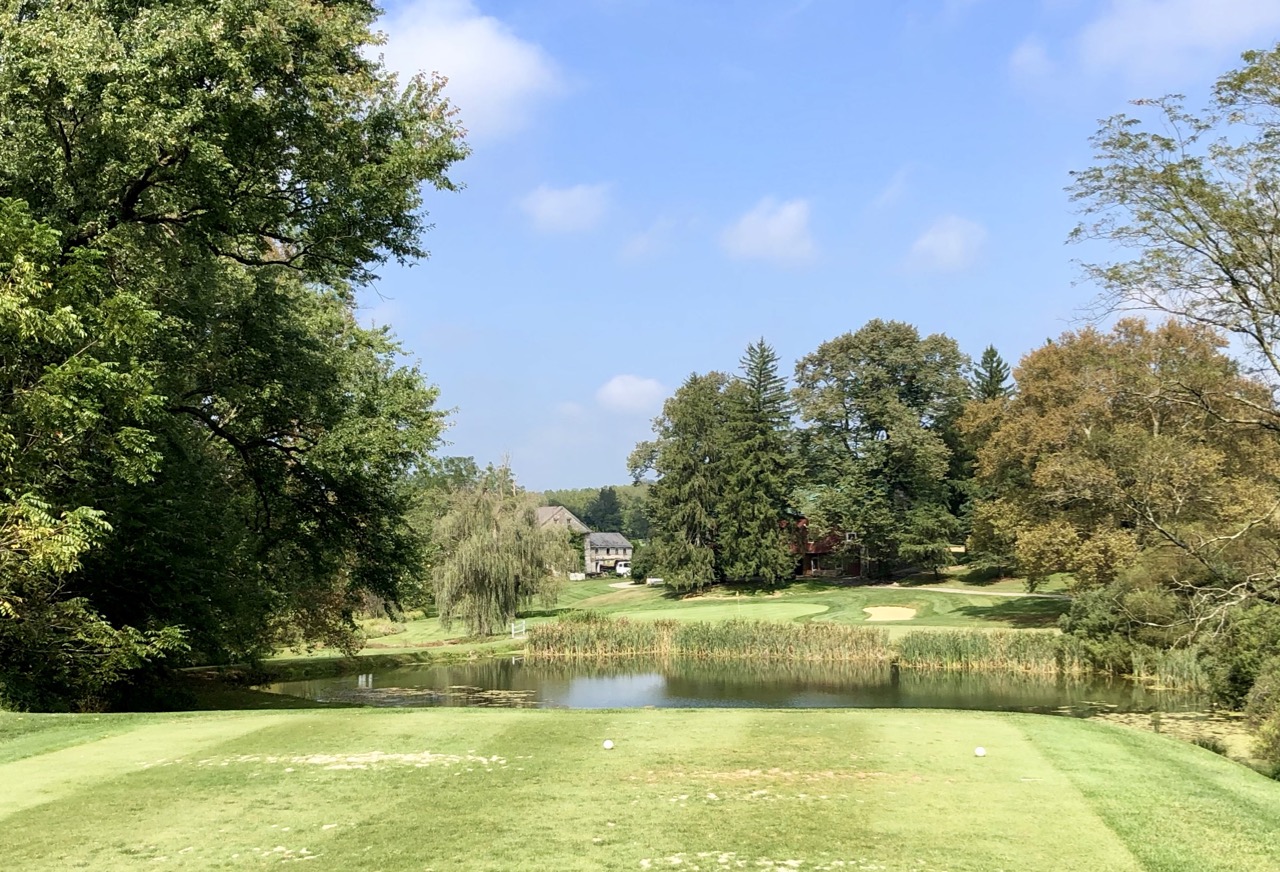 The par 3 15th hole at Berkleigh is the only hole on the course with significant in-play water, although a stream that runs throughout the property puts a few tee shots in jeopardy.
The par 3 15th hole at Berkleigh is the only hole on the course with significant in-play water, although a stream that runs throughout the property puts a few tee shots in jeopardy.
Length notwithstanding, I found the course fair and fun, with a few dogleg par 4s to add diversity to the round, and uniformly interesting par 3s, one over a pond. Water is an element on a few holes where a stream crosses quite close to fairway landing areas. (I rolled into one of them after what I thought was a good drive.) Berkleigh is a course that should probably be played a few times before you will feel comfortable choosing your clubs.
The golf course, which opened in 1926, is credited to Robert White, a Scotsman who was the first President of the Professional Golfer’s Association in 1916 and a founder of the American Society of Golf Course Architects. Traveling golfers may know him best for his design of Pine Lakes International, the oldest layout in Myrtle Beach, which was redesigned about 10 years ago. White has his name on some other notable courses, almost all of them in the New England and Middle Atlantic states. Berkleigh is part of the Byler Golf Trail, a collection of five courses located in the same general area of Pennsylvania. One of the trail’s courses, Iron Valley Golf Club in Lebanon, a P.B. Dye design, also makes the top 20 list of public facilities in the state.
If you should find yourself in eastern Pennsylvania, not far from Interstate 78, I encourage you to stop at Berkleigh for a four-hour (or less) round at a bargain price. Just make sure to turn off your phone as you head out to play.
Berkleigh Country Club
14623 Kutztown Road (Rt. 222)
Kutztown, PA
(610) 683-8268
https://www.berkleighgolf.com/
Page 60 of 1022























